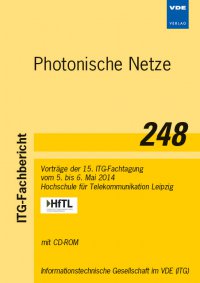Generation of high-quality carrier waves for future high-bitrate THz links
Conference: Photonische Netze - Vorträge der 15. ITG-Fachtagung
05/05/2014 - 05/06/2014 at Leipzig, Deutschland
Proceedings: Photonische Netze
Pages: 6Language: englishTyp: PDF
Personal VDE Members are entitled to a 10% discount on this title
Authors:
Preussler, Stefan; Schneider, Thomas (Hochschule für Telekommunikation Leipzig, Gustav-Freytag-Str. 43-45, 04277 Leipzig, Germany)
Braun, Ralf-Peter (Deutsche Telekom AG, Telekom Innovation Laboratories, Winterfeldtstr. 21, 10781 Berlin, Germany)
Grigat, Michael (Deutsche Telekom AG, Telekom Innovation Laboratories, Deutsche-Telekom-Allee 7, 64295 Darmstadt, Germany)
Abstract:
In commercial DWDM systems with channel bandwidths of 50 GHz, currently 100 Gbps can be transmitted. In order to transmit such high data rates via antennas, the radio wave needs a high carrier frequency in the millimeter or submillimeter and THz range. Due to the very high demands on the stability against fluctuating environmental conditions, the generation of such high carrier frequencies with exceptional quality (narrow linewidth, low phase noise, high stability of amplitude and frequency) at the transmitter or receiver is very difficult or impossible with existing technologies. A method for generating high-quality THz carrier waves is based on a highly accurate frequency comb generated by a femtosecond laser where all lines of the spectrum have the same phase relations. Subsequently, two frequency lines are separated by means of stimulated Brillouin scattering. This results in a fixed phase relationship between the two optical waves. These can be modulated arbitrarily and transported over the existing network infrastructure to the station with the corresponding photo mixer. First proof-of -concept experiments show a 100 GHz carrier wave with a phase noise of -104 dBc/Hz at a frequency offset of 10 kHz. The linewidth is found to be 1 Hz, due to the limiting measurement equipment. This contribution focuses on the different frequency comb sources as well as the different possibilities for the separation of the frequency lines and shows a practical realization for the generation of different carrier waves.


